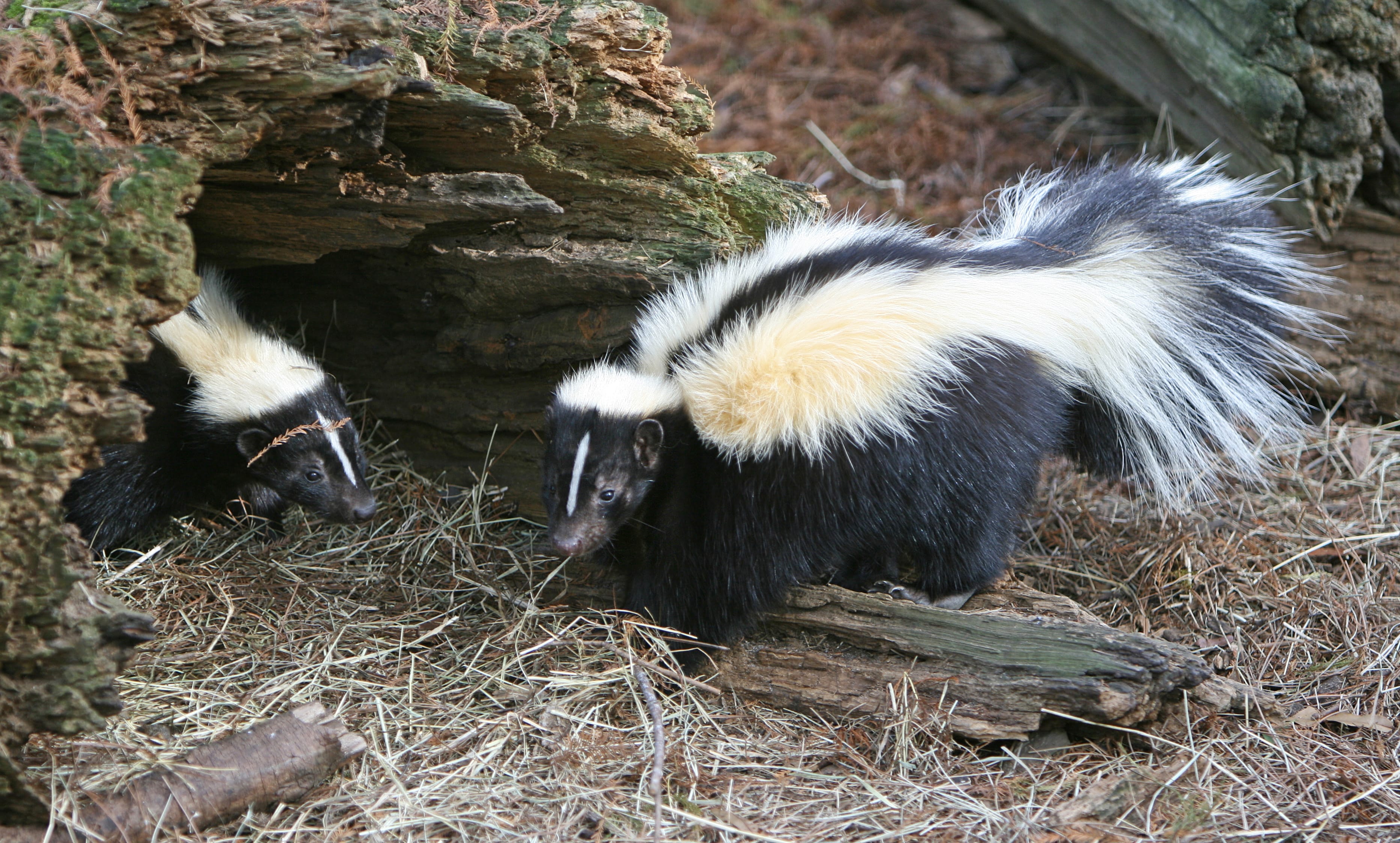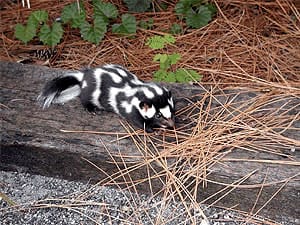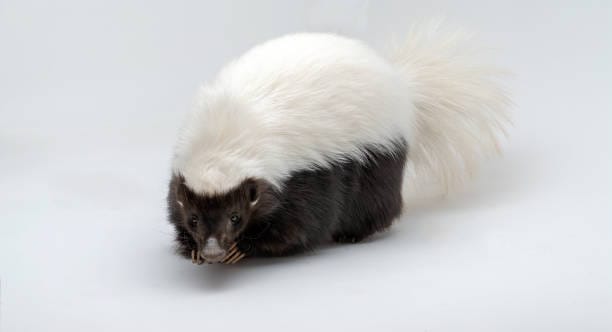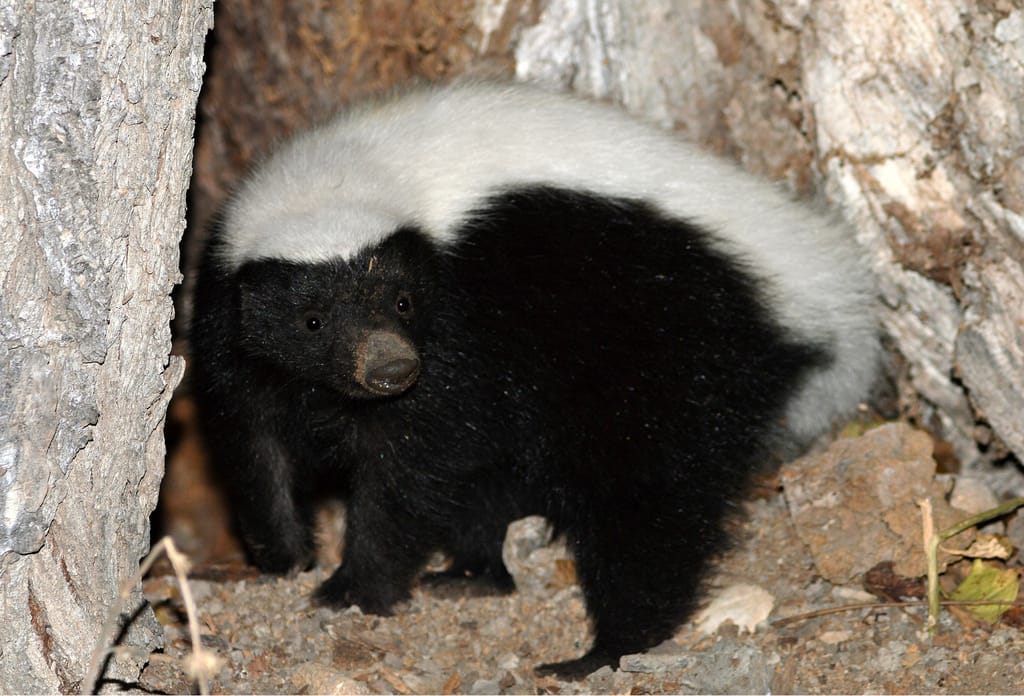Colorado hosts a fascinating diversity of skunks, each adapted to the state’s mountains, plains, and canyons. From the familiar striped skunk to elusive spotted species, these nocturnal mammals play a vital role in controlling insects and small rodents, while adding charm and intrigue to Colorado’s wildlife. Observing them requires patience, as many are wary of humans and only emerge at night or during twilight hours. Whether you are hiking along a foothill trail or exploring urban neighborhoods, understanding these skunks’ habits, physical traits, and ecological contributions enriches your appreciation for Colorado’s natural environment.
1. Striped Skunk (Mephitis mephitis)

Physical Characteristics & Identification Tips
Fun fact: the Striped Skunk is instantly recognizable by its dramatic black-and-white coloration. Adults measure 20–30 inches from head to tail, with broad white stripes running from head to tail, often converging along the spine. The bushy tail is predominantly white-tipped, used both for balance and warning gestures. They have sharp claws for digging and strong jaws for consuming insects, small rodents, and vegetation.
Behavior
Mostly nocturnal, Striped Skunks are cautious foragers, using a combination of keen senses and stealth. When threatened, they exhibit the classic defensive posture: arched back, raised tail, and a warning stomp before spraying a pungent chemical. Despite this infamous ability, most encounters end without the need for spraying if the skunk feels unthreatened. Their social behavior is subtle; they are largely solitary but can share dens in winter for warmth.
Habitat and Range
Striped Skunks are highly adaptable, found throughout Colorado’s plains, urban areas, and forest edges. They favor areas with dense shrubs or brush for cover and soil suitable for burrows. These adaptable mammals are often spotted near suburban backyards, farmland, or along roadways, taking advantage of abundant food sources and safe denning sites.
Diet
Omnivorous and opportunistic, Striped Skunks consume insects, small mammals, bird eggs, fruits, and vegetation. Insects are a critical summer food source, while nuts and fruits supplement their winter diet. They have excellent memory for food caches, often returning to previously visited foraging sites.
Reproduction and Life Cycle
Breeding occurs once a year, typically in late winter to early spring. Females produce litters of 4–7 kits, born blind and helpless in dens lined with soft vegetation. Kits develop rapidly, emerging above ground within six to eight weeks, and learn foraging and self-defense behaviors from their mother. Adults generally live up to 3 years in the wild, though predation and human-related hazards reduce longevity.
Fun Facts / Unique Traits
Striped Skunks are incredible pest controllers, consuming thousands of insects and larvae annually. Their spray is a sophisticated chemical defense, accurate up to 10 feet, and contains sulfur compounds that deter most predators. Observers may notice subtle “warning signs,” such as tail flicks or hissing, before a spray event.
Human Interaction
Encounters are common near homes, especially at night. While their spray is notorious, most skunks are shy and retreat if given space. Installing barriers around gardens and securing trash can prevent unwanted visits. Wildlife enthusiasts can observe them safely with motion-sensor cameras or at dusk when they emerge to forage.
2. Eastern Spotted Skunk (Spilogale putorius)

Physical Characteristics & Identification Tips
Fun fact: the Eastern Spotted Skunk is smaller and more delicate than the striped variant, measuring 12–20 inches including tail. Its striking pattern of broken white stripes and spots across a black coat distinguishes it from the more familiar striped skunk. A small white spot often appears on the forehead. Its slender frame allows rapid, nimble movements, perfect for escaping predators or navigating rocky terrain.
Behavior
Nocturnal and highly agile, this species can climb low shrubs or fences, unlike its more terrestrial cousin. When threatened, it performs a dramatic “handstand” with its front paws raised, tail curved over the back, and may even spray if provoked. It is primarily solitary but may share dens in colder months to conserve warmth.
Habitat and Range
Eastern Spotted Skunks inhabit eastern Colorado plains and foothills, often favoring open grasslands, abandoned buildings, and forest edges. Their dens are usually burrows or rock crevices, sometimes repurposing abandoned animal burrows. Habitat fragmentation can make spotting them challenging, but careful observation near fields and woodlots often reveals signs such as tracks or scat.
Diet
They are omnivores, feeding on insects, small mammals, eggs, berries, and seeds. Their diet shifts seasonally; insects dominate in summer, while seeds and fruits provide sustenance in fall and winter. This flexibility allows them to survive in diverse environments, from agricultural lands to suburban parks.
Reproduction and Life Cycle
Breeding occurs in late winter, with 3–5 kits born in spring. Young remain in the den for about six weeks, developing climbing and foraging skills. Eastern Spotted Skunks typically live 2–3 years, although predation and environmental pressures limit survival in the wild.
Fun Facts / Unique Traits
Their distinctive “handstand” display is unique among skunks and serves as both a warning and a bluff to predators. Despite their smaller size, they can deliver a surprisingly potent spray. Conservationists note that populations may be declining due to habitat loss, making sightings increasingly special.
Human Interaction
These skunks are rarely seen by humans due to their secretive, nocturnal nature. Installing nest boxes or preserving natural burrows may help maintain local populations. Observers should approach cautiously, appreciating their ecological role while respecting their space.
3. Western Spotted Skunk (Spilogale gracilis)

Physical Characteristics & Identification Tips
Fun fact: the Western Spotted Skunk closely resembles the Eastern species but has broader, broken stripes and a slightly larger body. Adults measure 14–21 inches, with a bushy, white-tipped tail. Their fur pattern is an intricate series of spots and broken stripes that serve as camouflage in foothill and canyon habitats. Keen observers may notice subtle differences in skull shape and tail length compared to Eastern variants.
Behavior
Like other spotted skunks, they are nocturnal and exceptionally agile, capable of short climbs and rapid movements to escape predators. Their handstand display is standard when threatened, followed by spraying if the threat persists. They are generally solitary, though winter dens may host multiple individuals for warmth.
Habitat and Range
Western Spotted Skunks are found primarily in Colorado’s western foothills, canyons, and open woodland regions. They favor areas with rock outcrops, logs, or abandoned burrows for shelter. They are rarely encountered in urban settings, preferring more rugged terrain and semi-arid habitats.
Diet
Their diet is similar to other spotted skunks: insects, small vertebrates, eggs, fruits, and seeds. Foraging occurs mostly on the ground but occasionally in low vegetation. Seasonal dietary adjustments allow them to survive in the varied climates of western Colorado.
Reproduction and Life Cycle
Breeding happens in late winter or early spring, producing litters of 3–5 kits. Young stay in dens for several weeks before venturing out. Adults live 2–4 years in the wild, with predation and food scarcity as primary limiting factors.
Fun Facts / Unique Traits
Western Spotted Skunks are skilled hunters of insects and small rodents, contributing to pest control in their habitats. Their climbing ability and nimble movements make them fascinating to watch, and their distinctive coloration is an excellent example of natural camouflage.
Human Interaction
These skunks are rarely a nuisance to humans, as they inhabit more remote areas. Observing them safely provides insight into nocturnal mammal behavior and the diversity of Colorado’s wildlife. Preserving natural shelters is key to supporting populations.
4. American Hog-Nosed Skunk (Conepatus leuconotus)

Physical Characteristics & Identification Tips
Fun fact: the American Hog-Nosed Skunk has a distinctive upturned nose, which it uses to sniff and dig for insects and larvae. Adults typically measure 22–30 inches, including their bushy tail. Their fur is mostly black with a broad white stripe along the back and tail, giving them a slightly “patched” appearance compared to striped skunks. They have strong forelimbs and long claws adapted for digging, making them appear almost like a miniature, furry bulldozer when foraging.
Behavior
Primarily nocturnal, Hog-Nosed Skunks are solitary and cautious. They use their remarkable sense of smell to locate food underground, often overturning soil and leaf litter. When threatened, they may raise their tail and arch their back, though their spray is less potent than that of striped skunks. They are known for slow, deliberate movements, reflecting their burrowing lifestyle.
Habitat and Range
In Colorado, Hog-Nosed Skunks are rare but historically found in southeastern plains and semi-arid regions. They prefer open grasslands, scrublands, and agricultural areas where soil is soft enough to dig burrows. These skunks are adept at finding shelter in abandoned dens, hollow logs, or dense vegetation, often choosing sites that provide protection from predators and harsh weather.
Diet
These skunks are insectivorous and omnivorous, feeding on beetles, larvae, grasshoppers, small mammals, amphibians, fruits, and occasionally seeds. Their digging behavior allows them to access prey unavailable to other skunks. Seasonal shifts occur, with insects dominating in summer and plant matter or eggs supplementing the diet during other months.
Reproduction and Life Cycle
Breeding occurs in late winter, producing litters of 2–5 kits in spring. Kits are born blind and helpless in dens, gradually developing mobility and foraging skills over the first six to eight weeks. Adults typically live 3–4 years in the wild, facing threats from predators, roadways, and habitat loss.
Fun Facts / Unique Traits
Hog-Nosed Skunks are excellent diggers and are often observed flipping rocks and soil in search of insects. Their unusual nose shape is highly specialized, providing an evolutionary advantage for ground foraging. Unlike other skunks, they sometimes use stealth and evasion rather than relying primarily on chemical defense.
Human Interaction
Hog-Nosed Skunks are rarely encountered by humans due to their low population density and nocturnal habits. When sightings occur, it is often near farmland or open fields. Educating locals about their role in controlling insect populations can promote coexistence and reduce unnecessary fear of these shy mammals.
5. Less-Common Subspecies / Colorado Variant Hog-Nosed Skunk

Physical Characteristics & Identification Tips
Fun fact: this subspecies or regional variant of the Hog-Nosed Skunk has subtle differences in fur pattern and body size, adapted to Colorado’s unique climate and terrain. Typically, adults are 21–28 inches long, with a black coat accented by a narrower white stripe along the back. Observers may notice slightly shorter limbs or variations in skull shape, reflecting adaptations to rocky foothills and semi-arid habitats.
Behavior
This variant displays similar nocturnal and solitary behavior as its species counterparts. They forage extensively for insects, grubs, and small vertebrates, often leaving characteristic dig marks in soil or leaf litter. Defensive displays are employed sparingly; this skunk prefers to retreat and hide in dense cover whenever possible. Observers might spot tracks or overturned debris as indirect evidence of their presence.
Habitat and Range
Found in scattered pockets of southeastern Colorado and some foothill regions, these skunks favor open grasslands with loose soil, rocky crevices, and abandoned burrows. Habitat fragmentation has limited their distribution, making sightings increasingly rare. They are well-adapted to Colorado’s seasonal temperature swings, utilizing dens to escape extreme heat or cold.
Diet
Omnivorous but heavily insectivorous, their diet includes beetles, crickets, larvae, small rodents, seeds, and fruits. Seasonal variation influences prey choice, with insects dominating in warmer months and plant material or eggs in colder periods. Their strong digging ability allows access to food that other skunks cannot reach.
Reproduction and Life Cycle
Breeding occurs in early spring, producing litters of 2–4 kits. Juveniles develop quickly, becoming independent after approximately eight weeks. Lifespan in the wild averages 3–4 years, though predation and human activity influence survival. Dens serve as both nurseries and winter shelters, highlighting the importance of habitat preservation.
Fun Facts / Unique Traits
This skunk’s subtle adaptations, like slightly smaller size or altered fur patterns, demonstrate the species’ flexibility in surviving diverse Colorado landscapes. Their nocturnal foraging behavior and powerful digging make them key players in local ecosystems, controlling insect populations and aerating soil.
Human Interaction
Rarely seen by humans, this variant is more often noticed indirectly through tracks, burrows, or garden disturbances. Promoting awareness about their ecological benefits can help reduce unnecessary conflicts and protect these little-known residents of Colorado’s wildlife community.
With these five skunks, Colorado showcases a remarkable diversity of nocturnal mammals. Each species, from the ubiquitous Striped Skunk to the elusive Hog-Nosed variants, contributes to pest control, seed dispersal, and ecological balance. Observing them requires patience, respect, and curiosity—whether through direct sightings, indirect signs, or careful nighttime exploration.
Frequently Asked Questions (FAQs) about Skunks in Colorado
1. Are there skunks in Colorado?
Yes, Colorado is home to several skunk species, including striped, spotted, and hog-nosed skunks.
2. How many types of skunks live in Colorado?
There are at least five commonly recognized types of skunks in Colorado.
3. What is the most common skunk in Colorado?
The Striped Skunk (Mephitis mephitis) is the most widespread and frequently seen species in the state.
4. Are spotted skunks found in Colorado?
Yes, both Eastern Spotted Skunks (Spilogale putorius) and Western Spotted Skunks (Spilogale gracilis) inhabit Colorado.
5. What is a Hog-Nosed Skunk?
The American Hog-Nosed Skunk (Conepatus leuconotus) is a rare species in Colorado with an upturned nose and distinctive white back stripe.
6. Can skunks spray humans?
Yes, all skunks have scent glands and can spray as a defense mechanism, but they usually warn first through postures and tail movements.
7. Are skunks nocturnal or diurnal in Colorado?
Most skunks are nocturnal, emerging at night or during twilight to forage for food.
8. What do skunks eat in Colorado?
Skunks are omnivorous, consuming insects, small mammals, eggs, fruits, seeds, and occasionally carrion.
9. Do skunks hibernate in Colorado?
No, skunks do not truly hibernate, but they may remain less active during the coldest winter months.
10. When do skunks breed in Colorado?
Skunks typically breed in late winter or early spring, with kits born a few weeks later.
11. How many babies do skunks have?
Litter sizes vary: Striped Skunks usually have 4–7 kits, while spotted and hog-nosed skunks may have 2–5 kits per litter.
12. Where do skunks live in Colorado?
Skunks inhabit forests, grasslands, urban areas, and agricultural lands, often using burrows, hollow logs, or dense vegetation for shelter.
13. Are skunks aggressive?
Skunks are generally shy and avoid confrontation, resorting to spraying only when threatened.
14. Are skunks dangerous to humans?
Skunks are not inherently dangerous, but they can transmit diseases like rabies in rare cases. Direct contact should be avoided.
15. Can skunks climb trees?
Spotted skunks are skilled climbers and can navigate low trees and shrubs, unlike Striped Skunks, which are mostly terrestrial.
16. How long do skunks live in the wild?
Most skunks live 2–4 years in the wild, though Striped Skunks occasionally reach 5 years under favorable conditions.
17. Are skunks solitary?
Yes, skunks are generally solitary except during breeding season or when sharing dens for warmth in winter.
18. Can skunks swim?
Yes, skunks are capable swimmers, though they usually prefer to travel on land.
19. Do skunks have natural predators in Colorado?
Yes, their predators include owls, hawks, foxes, coyotes, bobcats, and domestic dogs and cats.
20. How do skunks mark their territory?
Skunks use scent glands to mark territory and deter intruders, although visual and auditory signals are also used.
21. How do spotted skunks differ from striped skunks?
Spotted skunks are smaller, more agile, and display broken stripes or spots rather than continuous white stripes.
22. Are skunks beneficial to Colorado ecosystems?
Yes, skunks control insect populations, small rodents, and help aerate soil through digging, contributing to ecosystem balance.
23. Can I feed skunks in Colorado?
It is generally discouraged to feed wild skunks, as human food can harm them and create dependency or conflict.
24. Are Hog-Nosed Skunks endangered in Colorado?
They are rare and considered of conservation concern in the state due to limited distribution, but not officially endangered.
25. How can I tell the difference between Eastern and Western Spotted Skunks?
Eastern Spotted Skunks have narrower stripes and are more eastern in range; Western Spotted Skunks are larger with broader stripes and occupy western foothills and canyons.
26. Do skunks make noise?
Yes, skunks hiss, growl, and sometimes stomp their feet to warn predators before spraying.
27. Can skunks dig burrows?
Yes, Striped and Hog-Nosed Skunks are excellent diggers, creating burrows for shelter and foraging.
28. Are skunks active during the day?
Typically no, they are nocturnal, but in areas with abundant food or during winter, some may be seen during daylight.
29. How do skunks interact with humans?
Skunks generally avoid humans. Most interactions occur when humans unintentionally disturb a den or leave food accessible.
30. Can skunks be kept as pets in Colorado?
It is illegal to keep wild skunks as pets in Colorado without special permits, and it is discouraged due to disease risk and behavioral needs.
Conclusion
Colorado’s landscapes—from open plains to rugged foothills—are home to a fascinating array of skunks, each with distinct behaviors, diets, and adaptations. From the well-known Striped Skunk to the elusive Eastern and Western Spotted Skunks, and the specialized Hog-Nosed Skunks, these mammals play a critical role in controlling insect and small rodent populations while contributing to ecosystem health. Observing them offers insight into the nocturnal world of Colorado wildlife and highlights the delicate balance between humans and nature. Whether spotting one near a backyard, along a trail, or noticing their tracks and burrows, taking time to appreciate these creatures enriches our understanding of local biodiversity and emphasizes the importance of conserving their habitats.
Read more: 5 Types of Skunks in Indiana (Pictures and Identification)
